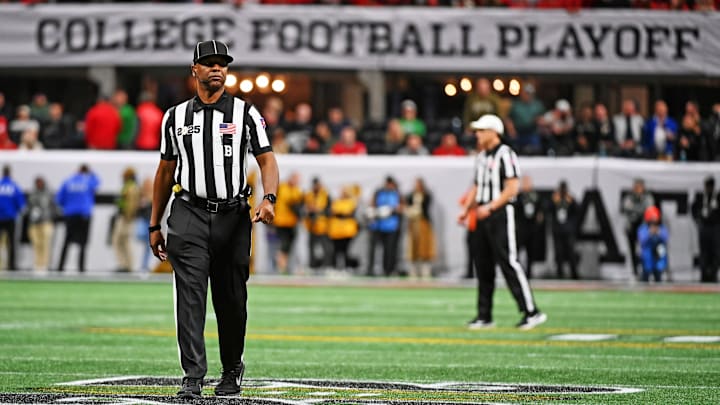The college football season is crawling ever closer. Teams are narrowing down their final depth charts, preparing for week 0 matchups (or week 1, I guess), and whittling down every possible imperfection before meaningful football games kick off at the month's end.
But the on-field product isn't the only aspect getting a facelift, as the rulebook has been subjected to a number of tweaks in the hopes that the actual game can be optimized, fast-tracked, and refined for the sake of the fan and the fairness of competition.
But let's be entirely honest, sometimes the verbiage of rulebooks is, well, dry. Complicated. Convoluted. Using the latest press release, courtesy of the NCAA, we'll lay out the new rules and provide an informal revision. In simple English: we're making a rule guide for dummies. Let's begin.
New NCAA Football Rule Changes for Dummies

Rule 1: Feigning Injuries
Official rule: To combat the practice of feigning injuries, the rules committee passed a rule that if a player presents as injured after the ball is spotted by officials, that team will be charged a Team Timeout or a delay penalty if all timeouts have been used. That player must remain out of the game for at least one down, even if that team is granted a team timeout and may not return to the game until receiving approval of professional medical personnel designated by their institution.
In English: Stop faking injuries. If a player gets hurt after the ball is spotted and ready to go, that's a team timeout. No timeouts? That's a delay of game penalty.
Rule 2: Timeouts in Extra Periods
Official rule: Currently, each team is permitted a team timeout in each extra period. To keep the game moving, now each team shall be allowed one timeout for the first extra period and one timeout for the second extra period. After the first two overtime periods, each team will be allowed only one timeout from the beginning of the third extra period until the game has ended. In addition, media timeouts will only be permitted after the first and second extra periods.
In English: If the game goes to third overtime, each team gets one timeout to use for the rest of the game.
Rule 3: Instant Replay Referee Announcement
Official rule: "Confirmed" and "Stands" are being replaced by "Upheld" in the Referee announcement after the review process determines that the ruling on the field will not be overturned. After video review, the referee shall make one of the following announcements:
- If the video evidence confirms the on-field ruling or if there is no clear and obvious evidence to overturn the on-field ruling: "After further review, the ruling on the field is upheld."
- If the on-field ruling is overturned: "After further review, the ruling is [followed by a brief description of the video evidence]. Therefore, [followed by a brief description of the impact of the ruling]."
In English: Refs won't say "Confirmed" or "Stands". If the first call was good, it's been "Upheld". You'll still hear the phrase "indesputable video evidence" from the broadcast every time a play goes under review.
Rule 4: "T" Signal on Kicks
Official rule: Any waving signal by any player of a return team is considered an invalid signal. The "T" signal given by a returner during any kick will now also be considered an invalid signal and will deprive the receiving team of the opportunity to advance the ball. This signal evolved as a signal to alert teammates that a kick returner was not going to return the kick. Now, after a "T" signal on kicks, there will be no return.
In English: If a kick returner holds his arms out in a "T" shape, the play is called dead.
Rule 5: Team Pre-Snap Movement
Official rule: Any defensive team player within one yard of the line of scrimmage (stationary or not) may not make quick and abrupt or exaggerated actions that simulate action at the snap and are not part of normal defensive player movement in an obvious attempt to make the offense foul. This will continue as a point of emphasis in the game. The offense will be held to the same standard as any pre-snap movement that simulates action at the snap is a foul on the offense for a false start.
In English: The defense can't do anything to make the offense false start.
Rule 6: Disconcerting Signals
Official rule: No player shall use words or signals that disconcert opponents when they are preparing to put the ball in play. No player may call defensive signals that simulate the sound or cadence of, or otherwise interfere with, offensive starting signals. New for 2025, the terms "move" and "stem" are reserved for defensive cadence and may not be used by the offense. The offense may use a "clap" as a starting signal and this signal may not be used by the defense.
In English: The offense also can't say the words "move" and "stem". The defense can't clap. Same reason as rule 5.
Hopefully that helps to take a bit of the mystery out of the rulebook. If not, thanks for reading anyway. you didn't have to, yet your eyes have found their way to the bottom of the page regardless. How about that?
